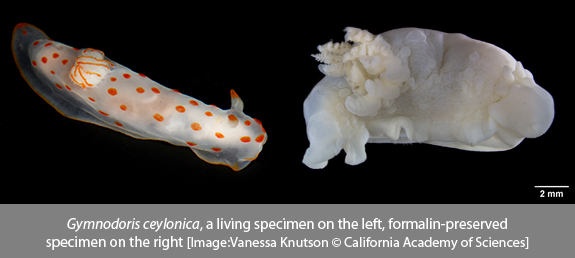Last time I wrote about how we collect nudibranchs in the field. This time I want to tell you a little bit about the preservation process.
First, I’d like to explain briefly why we make collections at all. Here at the Academy, and other natural history museums around the world, we have a library of life— preserved specimens collected from different locations and different times. We have everything from plants to insects to fish to my favorite- nudibranchs. These collections allow biologists to study the biodiversity of our planet and to study how populations and species of living things change over time. This is an aspect of the Academy that you may not see directly when you visit, but behind the museum walls, there are about 28 million specimens and several biologists that study them.

Different groups of organisms have different methods of preservation. If you were to visit the collections, you would find pinned insects, dry shells, bird and mammal skins and many specimens in jars. The method of preservation depends on the nature of the animal (Does it have a soft body? A hard exoskeleton? Does it have parts that will dissolve in a certain kind of preservative?), the history/tradition of research on that organism and the preferences or convenience of the people doing the collecting. The nudibranchs on our shelves are mostly initially preserved (fixed) in ethanol (ethyl alcohol, the same stuff as in drinking alcohol), formalin (a solution of formaldehyde, which is a gas), or Bouin’s solution (a solution of picric acid, acetic acid and formaldehyde). Each preservation method has pros and cons, depending on what you need from the specimen.

Many of our older nudibranch specimens were initially preserved in formalin or Bouin’s solution. These preservation methods are great for preserving soft tissues, which make dissection a lot easier. This is useful when we are interested in looking at the internal differences or similarities between species. However, these solutions can degrade DNA. Because I use DNA as a tool for my research, I need specimens that have been preserved in ethanol. Unfortunately, because many of the older specimens were preserved in formalin or Bouin’s solution, I cannot use them in my DNA study. However, these specimens are far superior for dissection, so either preservation method involves some compromise.
So how do we preserve them?
As just about anyone who has ever seen a nudibranch will tell you, nudibranchs are BEAUTIFUL creatures. Some refer to them as the butterflies of the sea because they are so charismatic and colorful. Unfortunately, no matter what solution we preserve them in, they lose their color (we sure wish this wasn’t the case, as they’d be a lot more exciting to show the public if they still had color!). This means that it is essential to document what these animals look like while they are still alive. This is why photography is so important for what we do. Without a photo, we have no way to know what the animal looked like when it was alive.

After we photograph the animals, we put them to sleep (anaesthetize them) using a solution of magnesium chloride and seawater. How long it takes for them to drift off into dreamland depends on the size of the animal- the larger the animal, the longer it takes. I’ve spent several nights up until ungodly hours waiting for these slugs to become anaesthetized. Once the nudibranchs stop moving, we place them in the preservative (ethanol, formalin, or Bouin solution).
If the animal is preserved in alcohol, it should be good to go for DNA extraction. Unfortunately, these alcohol-preserved specimens become very brittle, which makes dissection very challenging. The bodies also tend to become a lot more distorted when preserved in ethanol. One alternative is to take a small piece of the animal to store in ethanol, while the rest gets preserved in formalin or Bouin’s solution. However, a problem with this method is that if you run out of the DNA extraction, you can’t extract any more DNA!
Ultimately, each method of preservation comes with some sort of compromise, but the ultimate goal is to preserve these specimens to better understand life on our planet.
That is all for this week. Till next time!
Vanessa Knutson
Project Lab Coordinator and Graduate Student
Department of Invertebrate Zoology and Geology